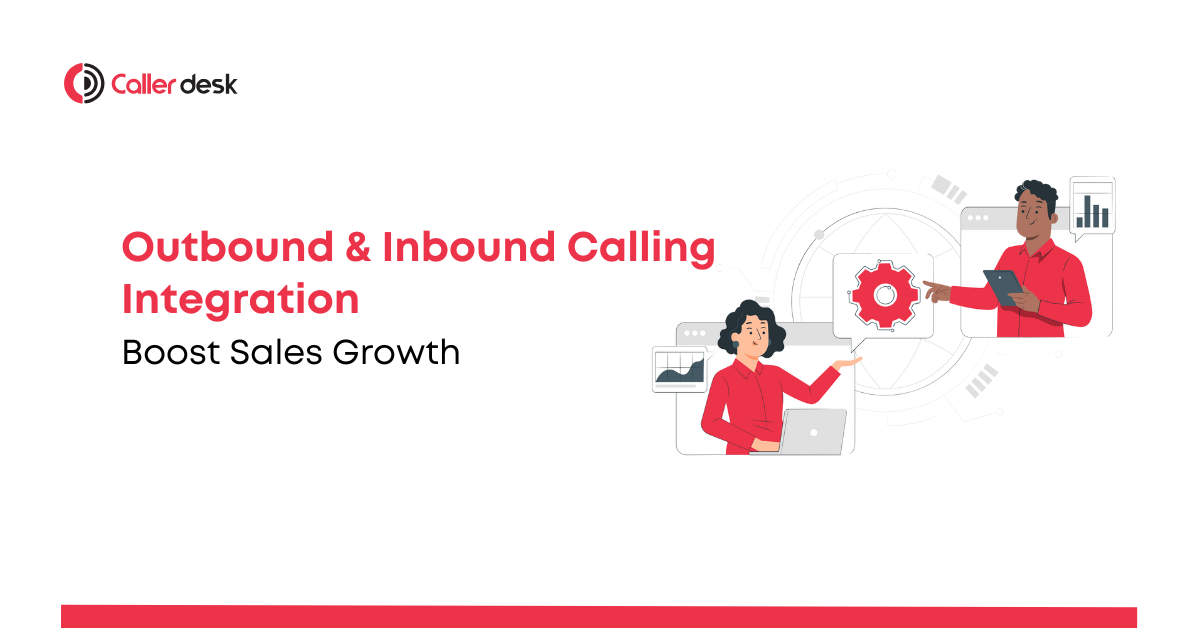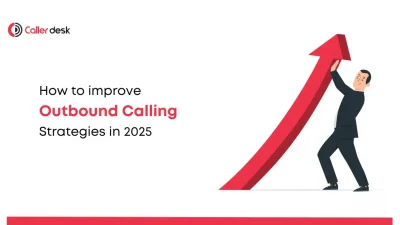Sales success hinges on one crucial factor: meaningful communication. In an era where customer expectations are rising, businesses must adopt smarter strategies to engage prospects, nurture leads, and deliver unparalleled customer support. Integrating outbound calling and inbound calling into your sales strategy creates a seamless, customer-first communication framework that drives growth and strengthens relationships.
Outbound calling involves proactive outreach to prospects and customers for purposes such as lead generation, sales follow-ups, and market research. On the other hand, inbound calling is customer-initiated, often involving support inquiries, product questions, or purchase decisions. While each has unique strengths, their combined power lies in creating consistent, high-quality interactions throughout the customer journey.
This guide explores how integrating outbound and inbound calling can transform your sales strategy, maximise efficiency, and improve customer satisfaction.
Why Integrate Outbound and Inbound Calling?
Integrating outbound and inbound calling doesn’t just streamline processes; it redefines how businesses connect with their audience. Together, these strategies ensure every interaction—whether initiated by the business or the customer—is impactful and productive.
Key Benefits of Integration
- Comprehensive Customer Engagement: Engage proactively through outbound calls and respond effectively through inbound channels, ensuring no customer is overlooked.
- Higher Conversion Rates: Integrated strategies can increase lead conversion rates by up to 35%, as they align outreach efforts with customer inquiries.
- Enhanced Resource Efficiency: Reduce idle agent time by balancing proactive and reactive call loads.
- Improved Customer Loyalty: Consistent, seamless communication fosters trust and long-term relationships.
- Data-Driven Decision Making: Combined insights from both approaches help businesses refine strategies, identify trends, and improve outcomes.
How to Integrate Outbound and Inbound Calling
1. Unified Lead Generation
Outbound calling excels at creating new opportunities, while inbound channels capture leads driven by interest.
- Outbound: Use targeted campaigns to introduce your offerings and spark interest among cold leads.
- Inbound: Capture inquiries from potential customers responding to your marketing efforts, such as online ads or content downloads.
Example:
An insurance company can use outbound calls to inform potential clients about a new policy while capturing inbound leads from a website form offering free insurance quotes.
2. Strengthened Lead Nurturing
Nurturing leads is vital to moving them through the sales funnel.
- Use outbound calls to re-engage inactive leads or follow up on previous interactions.
- Leverage inbound calls to address customer questions, offer additional details, or assist in decision-making.
Example:
A SaaS provider conducts outbound calls to encourage free trial sign-ups and uses inbound channels to assist trial users in transitioning to paid plans.
3. Proactive Customer Support & Upselling
Provide value at every stage by combining inbound support with outbound opportunities.
- Use inbound calls to handle customer complaints, inquiries, or technical issues.
- Follow up with outbound calls to suggest upgrades, complementary services, or renewal reminders.
Example:
A telecommunications provider resolves a service issue via an inbound call, then follows up with an outbound call offering a discounted high-speed internet plan.
4. Continuous Feedback & Improvement
Gathering feedback ensures that your products, services, and interactions remain aligned with customer expectations.
- Conduct outbound surveys to collect feedback on recent purchases or interactions.
- Offer inbound support lines where customers can voice concerns or share suggestions.
Example:
A retail brand makes outbound calls to gauge satisfaction with its delivery service and encourages customers to report issues or ask questions via an inbound helpline.
5. Expand Communication with Omnichannel Integration
Enhance the customer experience by integrating other communication channels, such as email, chat, and social media, alongside your inbound and outbound calling efforts.
How CallerDesk Helps:
CallerDesk’s omnichannel platform ensures a seamless flow of communication across multiple channels, providing a unified customer experience.
Metrics to Track for Integration Success
Tracking the right metrics is essential for evaluating the effectiveness of your integrated strategy.
Key Performance Indicators (KPIs):
- Call Pickup Rates: Measure how often customers answer outbound calls.
- Conversion Rates: Evaluate the percentage of calls that result in successful outcomes (e.g., sales or bookings).
- Customer Satisfaction Scores (CSAT): Gauge how satisfied customers are with their interactions.
- First Call Resolution (FCR): Track how often issues are resolved in a single inbound call.
- Average Handle Time (AHT): Monitor the efficiency of your agents in handling both inbound and outbound calls.
How CallerDesk Helps:
CallerDesk’s analytics dashboard provides real-time insights into these KPIs, empowering businesses to refine their strategies and enhance performance.
CallerDesk: Simplifying Integration
CallerDesk makes integrating outbound and inbound calling effortless with its advanced cloud telephony platform.
| Feature | How It Helps |
| AI-Powered Predictive Dialers | Automates outbound calls, connecting agents to live prospects faster and reducing idle time. |
| Omnichannel Integration | Combines calls, emails, chats, and social media for seamless communication. |
| Real-Time Monitoring | Tracks agent performance and call metrics to ensure quality interactions. |
| Intelligent Call Routing | Directs inbound calls to the most qualified agents, improving resolution times. |
| Customised Reporting | Provides actionable insights into customer behaviour and campaign performance. |
| Compliance Management | Ensures adherence to DNC regulations and data privacy standards like GDPR and CCPA. |
Tips for a Successful Integration
1. Invest in Technology
Modern tools like predictive dialers and CRM systems are crucial for a smooth integration.
CallerDesk Advantage:
CallerDesk’s CRM integration and real-time analytics provide a 360-degree view of customer interactions.
2. Train Your Team
Agents must be equipped to handle both outbound and inbound calls confidently.
CallerDesk Advantage:
With CallerDesk’s training and monitoring tools, managers can coach agents to excel in all customer interactions.
3. Focus on Compliance
Adhering to regulatory requirements is non-negotiable for both outbound and inbound strategies.
CallerDesk Advantage:
CallerDesk simplifies compliance with automated DNC checks, consent tracking, and secure data handling.
Call to Action
Transform your sales strategy with integrated outbound and inbound calling. Let CallerDesk empower your business with tools that drive growth, improve customer engagement, and streamline operations.
Take the first step today—schedule a demo and unlock the full potential of integrated calling with CallerDesk!
Frequently Asked Questions
1. What is the difference between outbound and inbound calling?
Outbound calling is a proactive communication strategy where businesses reach out to customers or prospects for purposes such as lead generation, follow-ups, or sales. In contrast, inbound calling is reactive, where customers initiate contact with the business to seek support, inquire about products, or make purchases. Both approaches serve unique purposes and, when integrated, create a seamless customer communication framework.
2. Why should businesses integrate outbound and inbound calling?
Integrating outbound and inbound calling provides a unified communication strategy that enhances customer engagement and satisfaction. It allows businesses to proactively reach out to leads while also effectively addressing customer queries, creating a cohesive experience. This integration can lead to higher conversion rates, improved resource utilisation, and better customer loyalty by ensuring that every interaction is meaningful and efficient.
3. How do outbound and inbound calling complement each other?
Outbound and inbound calling complement each other by addressing different stages of the customer journey. Outbound calls are ideal for generating leads, conducting follow-ups, or promoting services, while inbound calls help manage customer inquiries, provide support, and close sales. By combining the two, businesses ensure they are available when customers need them and can also proactively engage prospects at the right time.
4. What technologies are essential for integration?
The key technologies for integration include predictive dialers to automate outbound calls, CRM systems to centralise customer data and track interactions, and analytics platforms to monitor performance metrics. CallerDesk offers all these tools in a unified platform, simplifying the integration process while enhancing efficiency and effectiveness.
5. How does CallerDesk support integration?
CallerDesk simplifies the integration of outbound and inbound calling with advanced tools like AI-powered predictive dialers, omnichannel communication systems, real-time analytics, and compliance management features. Its platform allows businesses to manage all interactions seamlessly while providing actionable insights and ensuring adherence to regulatory standards.
6. What metrics should businesses track for integration success?
To measure the success of integrating outbound and inbound calling, businesses should track metrics like call pickup rates, conversion rates, customer satisfaction scores (CSAT), first-call resolution (FCR), and average handle time (AHT). CallerDesk’s real-time analytics dashboard helps businesses monitor these metrics and refine their strategies for continuous improvement.
7. Can small businesses benefit from integrated calling?
Yes, small businesses can significantly benefit from integrating outbound and inbound calling. CallerDesk’s scalable solutions enable businesses of all sizes to optimise communication, improve customer engagement, and achieve better results without requiring a large infrastructure or budget.
8. How can businesses ensure compliance during integration?
Compliance is critical for maintaining customer trust and adhering to legal standards. Businesses should use Do Not Call (DNC) lists, secure customer consent, and follow data privacy regulations like GDPR or CCPA. CallerDesk simplifies these tasks with automated DNC checks, secure data handling, and compliance tracking features, ensuring peace of mind for businesses.
9. What challenges might arise during integration?
Challenges during integration may include training agents to handle both outbound and inbound calls, ensuring data consistency across platforms, and adopting new technologies. CallerDesk addresses these issues by offering intuitive tools, robust CRM integration, and training features that empower agents and streamline operations.
10. How can I start using CallerDesk for integrated calling?
To begin integrating outbound and inbound calling with CallerDesk, contact their team to schedule a demo. Their platform provides everything you need to enhance customer communication, optimise your sales strategy, and achieve measurable growth.





